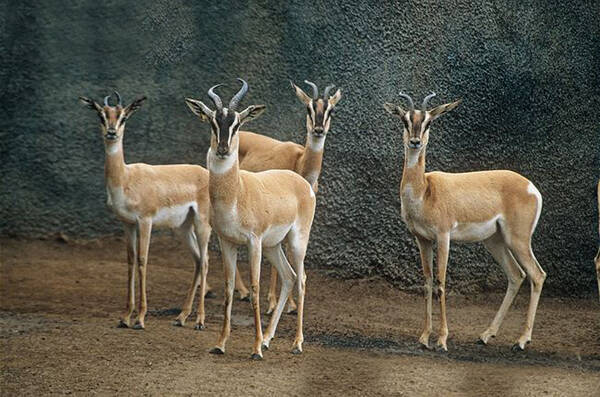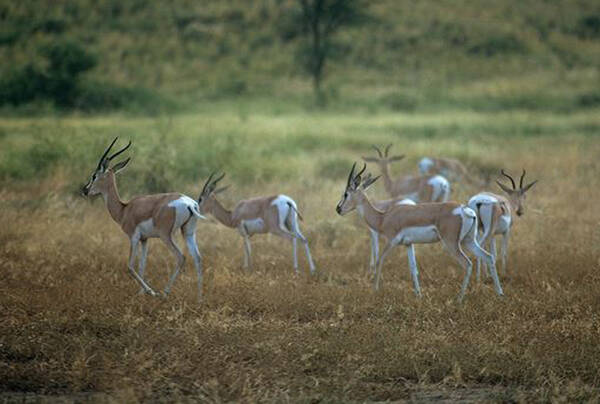Nanger soemmerringii
IUCN
LCBasic Information
Scientific classification
- name:Nanger soemmerringii
- Scientific Name:Nanger soemmerringii,Sudanese antelope, Sumerian antelope
- Outline:Ungulata
- Family:Artiodactyla Bovidae Antelope
Vital signs
- length:125-150cm
- Weight:28.5-38.6kg
- lifetime:About 14 years
Feature
The general body color is light yellow-brown, the lower body is white, with a clear dividing line
Distribution and Habitat
The Somali Oryx lives in the Horn of Africa, native to Djibouti, Eritrea, Ethiopia, Kenya, Somalia and Sudan.
It inhabits hilly areas and semi-arid grasslands, usually areas with acacia trees and shrubs.
Appearance
The Somali Goral has a head-body length of 125-150 cm, a shoulder height of 81-90 cm, and a tail length of 18-23 cm; it weighs 28.5-38.6 kg. It has short, heavy, lyre-shaped horns that are swept back and pointed at the tip. The male horns are 38-48 cm long, but exceptional specimens may exceed 58 cm. The female's horns are much thinner and less than the horizontal curve, and are usually shorter, and can exceed 40 cm.
It is a large, sturdy antelope, with males larger than females. They have particularly strong necks. The general body color is light yellow-brown, and the underparts are strikingly white; these two colors are divided by a distinct horizontal line across the side of the body. There is a large white patch on the rump that extends above the base of the tail and protrudes forward to the hip. The tail is white with a tuft of black fur at the end of the tail. The cheeks have striking stripes. In the center of the face, there is a dark stripe from the horns to the muzzle,
Details
Somali gazelle (scientific name: Nanger soemmerringii) is also known as Soemmerring's Gazelle in foreign languages. There are three subspecies.

Once upon a time, the attractive Somali gazelle would gather in large groups of hundreds during seasonal migration. This spectacular sight is already very rare. The Somali antelopes usually gather in herds of 15 or fewer. These groups consist of females and their young, accompanied by an adult male in their territory. Males mark their territories with feces, and violent confrontations may occur if another male ventures into his territory. Such encounters involve butting heads on the ground, butting heads, and swinging the body sideways to attack the opponent.
The Somali antelopes feed mainly on grass, and their narrow muzzles and flexible lips allow them to carefully select the best grass. The main natural enemies of the Somali antelopes are carnivores, including cheetahs, lions, leopards, hunting dogs, hyenas and even pythons.
The Somali antelopes mate between September and November. The gestation period is about 198 days. The female antelope gives birth to one calf each time. It usually takes about a month for the calf to be strong enough to keep up with its mother. During this period, the female antelope can only guard its calf at any time to care for and protect it. The weaning period of the calf is 6 months. The sexual maturity of the Somali antelope is only 18 months, when it can reproduce and live up to 14 years.

The Somali Goral has a narrow and limited distribution range and is considered to have a moderate decline in numbers. The decline is due to habitat loss, reduced precipitation, tourism impacts and road development, which have changed the living environment. It has been listed as a vulnerable species.
The only effectively protected population of the Somali Goral is on Dahlak Kebir Island in the Elekh tribe. They are highly valued by local communities and in Awash National Park in Ethiopia. The Buri Peninsula in Eritrea is designated as a protected area. There are no functioning protected areas in Somalia. There are a small number of well-managed captive Somali Gorals. Unless effective conservation and management are implemented over a larger area, the overall distribution and abundance of the species will continue to decline.
Listed in the 2016 IUCN Red List of Threatened Species, ver 3.1 - Vulnerable (VU).
Protect wild animals and stop eating game.
Maintaining ecological balance is everyone's responsibility!








